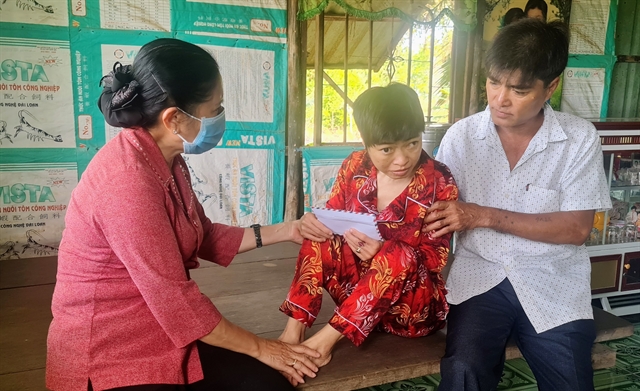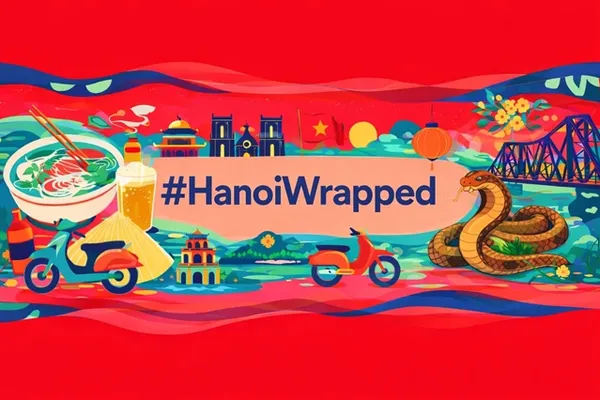 Society
Society

 |
| A member of the Bạc Liêu Province branch of the Việt Nam Association of Victims of Agent Orange visits an victim. — VNA/VNS Photo Tuấn Kiệt |
HÀ NỘI — Supporting victims of Agent Orange (AO) is not only a charitable and humanitarian deed but is also the responsibility of every Vietnamese person, to express gratitude to those who gave so much to the revolution and protecting Việt Nam.
August 10 marks 61 years since the beginning of AO/Dioxin warfare in Việt Nam, the longest chemical warfare operation in history.
According to Việt Nam Association of Victims of AO/Dioxin (VAVA), the US military sprayed 80 million litres of toxic chemicals on the south of Việt Nam between 1961 and 1971, with 61 per cent being AO containing 366kg of dioxin, over nearly 3.06 million hectares (equivalent to nearly one-quarter of the south’s total area).
Preliminary statistics showed that 4.8 million Vietnamese people were exposed to AO/dioxin, and about 3 million people became victims. Tens of thousands of people died while millions of others suffer from cancer and other incurable diseases as a result. Many of their children also suffer from various birth deformities that range from debilitating to serious diseases that shorten lifespans.
Sen. Lt. Gen. Nguyễn Văn Rinh, Chairman of the Việt Nam Association of Victims of AO/Dioxin (VAVA), said the Party, State, and people have made wholehearted efforts with the highest sense of responsibility to care for revolution contributors, including those suffering from toxic chemicals in the resistance war, and AO victims.
Many policies on the settlement of AO consequences have been carried out, he said, noting that the State spends tens of trillions of đồng each year on providing monthly allowances, health care, and functional rehabilitation for AO victims and aiding AO-hit areas.
More than 320,000 people engaging in the resistance war and their children were infected with AO and are currently entitled to preferential policies for revolution contributors. Families of the disabled, including AO victims, have also benefited from health insurance or free medical services.
Hundreds of thousands of people with serious disabilities, including AO victims, have received orthopaedic surgeries and functional rehabilitation while tens of thousands of children, including those suffering from indirect AO impacts, have received assistance to attend specialised schools.
Those policies have created favourable conditions for AO-infected persons who performed duties in the resistance war, and residents in affected areas, to provide them with a stable life, Rinh added.
In addition, VAVA raises hundreds of billions of đồng from domestic and foreign sources each year to help AO victims build and repair houses, recover corporal functions, seek health examinations and treatment, undergo vocational training, pursue learning, and develop livelihoods.
Since the VAVA establishment in January 2004, more than VNĐ2.66 trillion (nearly US$113.7 million) has been donated to the Fund for AO Victims, he said.
There are now 12 peace and friendship villages along with several nursing centres for disabled children, most of whom suffer from deformities caused by AO. The reproductive genetic counselling centres in Hà Nội and HCM City have also been working to reduce the rate of babies born with birth defects. Some localities have also conducted psychological trauma surveys and provided mental health assistance for AO victims, he added.
Besides, VAVA has brought into play its role as the core force in fighting for justice for AO victims.
Rinh said the struggle for justice for Vietnamese victims of AO has been carried out in various forms and obtained significant outcomes.
In particular, since 2007, the US Congress has approved an annual budget for the US Government to help with the environmental remediation of dioxin contamination in Việt Nam. The remediation was completed at Đà Nẵng Airport in 2018 and then moved on to the Biên Hoà Airbase.
The US Government also carried out a programme to support AO victims during 2016-20, at a total cost of US$21 million. Another programme worth $65 million for the 2021-25 period is being promoted in some provinces hit hard by toxic chemicals during the war.
Rinh expressed his belief that with assistance from all-level authorities, sectors, localities, domestic organisations and individuals, as well as international friends, the AO pain will be gradually eased, and more AO victims and their families will surmount difficulties to move forward. — VNS




